Submitted by Antonello Magliozzi
Sustainability vision throughout the Dubai Expo experience
Italy Architecture News - Jan 31, 2022 - 22:55 4365 views

We aspire to deliver one of the most sustainable World Expos ever! This is the main ambition of the biggest event in the history of the Middle East, the Dubai Expo 2020, running from October 2021 to March 2022 in the City of Hope. In the United Arab Emirates, in a country that has a history of 50 years, but a millennial tradition that considers water and land as sources of life. In the "land of dreamers who do", where the future is built through the union of peoples and cultures, thanks to the values of "connecting minds, creating the future", with a boldness that comes from the awareness of the past. All this in a context that affirms the need for a guiding philosophical thought, which can be summed up by Gaston Bachelard's aphorism, present at the end of one of the most iconic narrative paths of the exhibition, in the Alif pavilion: “One must always maintain one’s connection to the past and yet ceaselessly pull away from it!” A symbolic value expressed by the logo of Expo Dubai 2020 itself, which is inspired by the shape of an ancient ring found at Saruq Al Hadid, also associated with the principle of continuity between past and future.
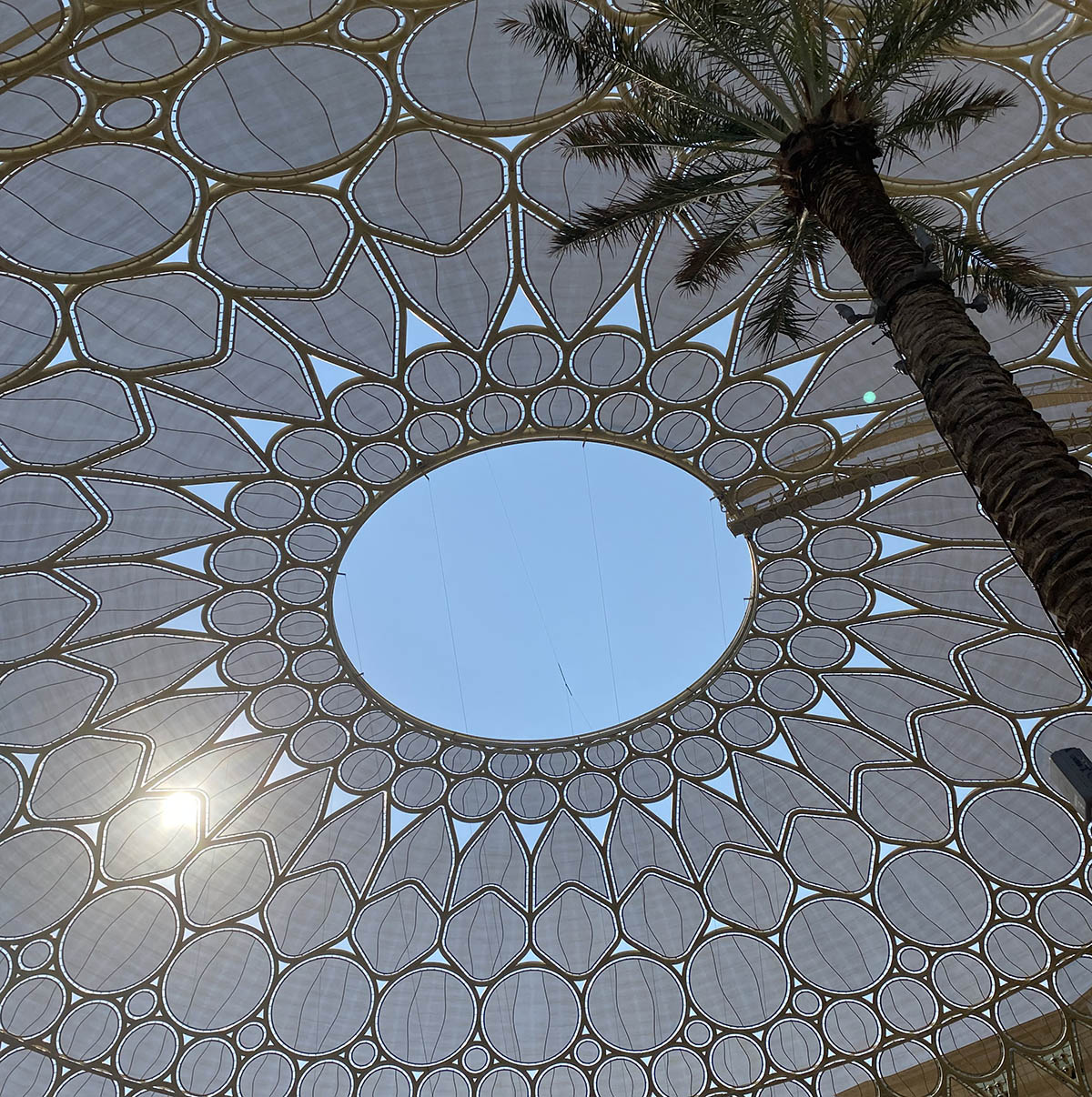
Saruq Al Hadid ring shape the Expo 2020 logo and the Al Was dom pattern . Image © Antonello Magliozzi
On this basis, the Dubai Expo creates a bridge between a past of dependence on fossil fuels and a future oriented towards the need for change and innovation. A scenario recounting the ambitions and hopes of 192 countries in an international panorama dominated by concerns over the persistent pandemic, together with those relating to environmental emergencies. The expo then creates an idea of the future based on the awareness of a world full of opportunities and sustainable actions, already underway in the various countries with great motivational drivers. All this according to the script of the universal expositions, where the best of technology and innovations are shown, but with an additional, non-deferrable strategic value, the one represented by the green economy of sustainable development. A goal now defined measurable, as reported by the organizers of the exhibition themselves, according to GRI standards, and consistent with the vision of Sheikh Zayed bin Sultan Al Nahyan. In fact, in the introduction to the Sustainability Report 2020, the founder of the UAE states: "We pay the utmost care and attention to our environment because it is an integral part of the country, our history and our heritage. Our ancestors and forefathers lived on this land and coexisted with its environment, on land and sea, and instinctively understood the need to preserve it."
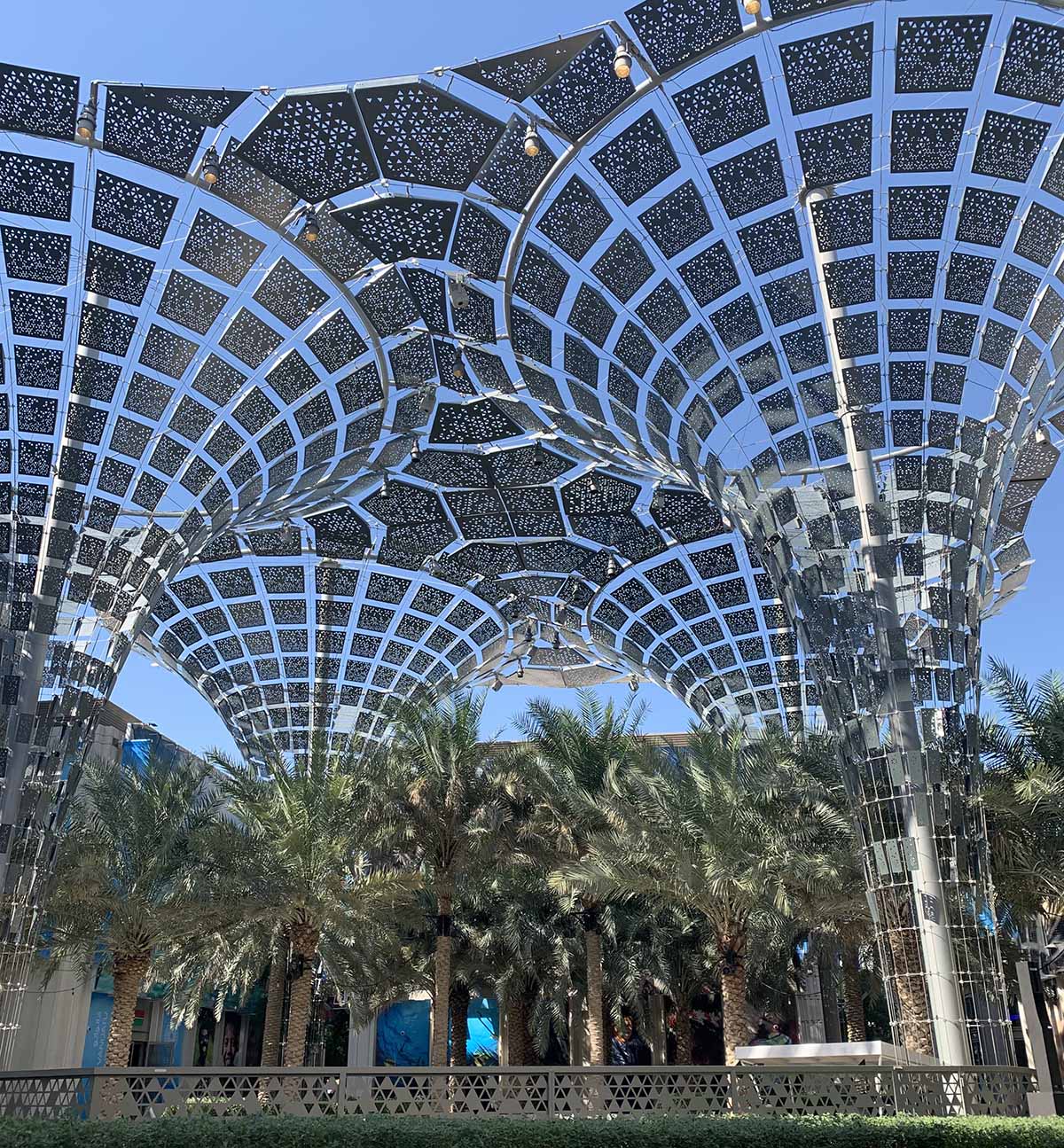
Dubai Expo green pathways. Image © Antonello Magliozzi
Located in Jebel Ali, on the southwestern edge of Dubai, on an area of about 4.3 square kilometers, Expo 2020 represents the future in a thriving oasis, with an urban design inspired by the traditional Arab souk. It stems from a masterplan conceived by HOK firm in 2013, depicting the shape of a flower with three petals to represent a human-centered, intelligent and sustainable city. The pistil of the flower shapes the heart of the complex with the central square called Al Wasl, meaning "connection," while the three petals represent the thematic districts, respectively intended for meaning innovation in terms of: Sustainability, Mobility and Opportunity. The overall design involved larger pavilions along the perimeter and the clustering of smaller exhibition spaces towards the center, with a fluid pedestrian flow to encourage interaction among visitors. All this with diffuse canopies made of photovoltaic fabrics, acting as a sunshade and a collector of renewable energy. A huge stage that considers the visitor as the protagonist in the choice of itineraries and paths, who sometimes interacts with robots or aquatic sets, while at other times witnesses spectacular performances of semi-permanent installations. Everything is thus set in a context of multimedia communications that create a background for green skills' sharing.
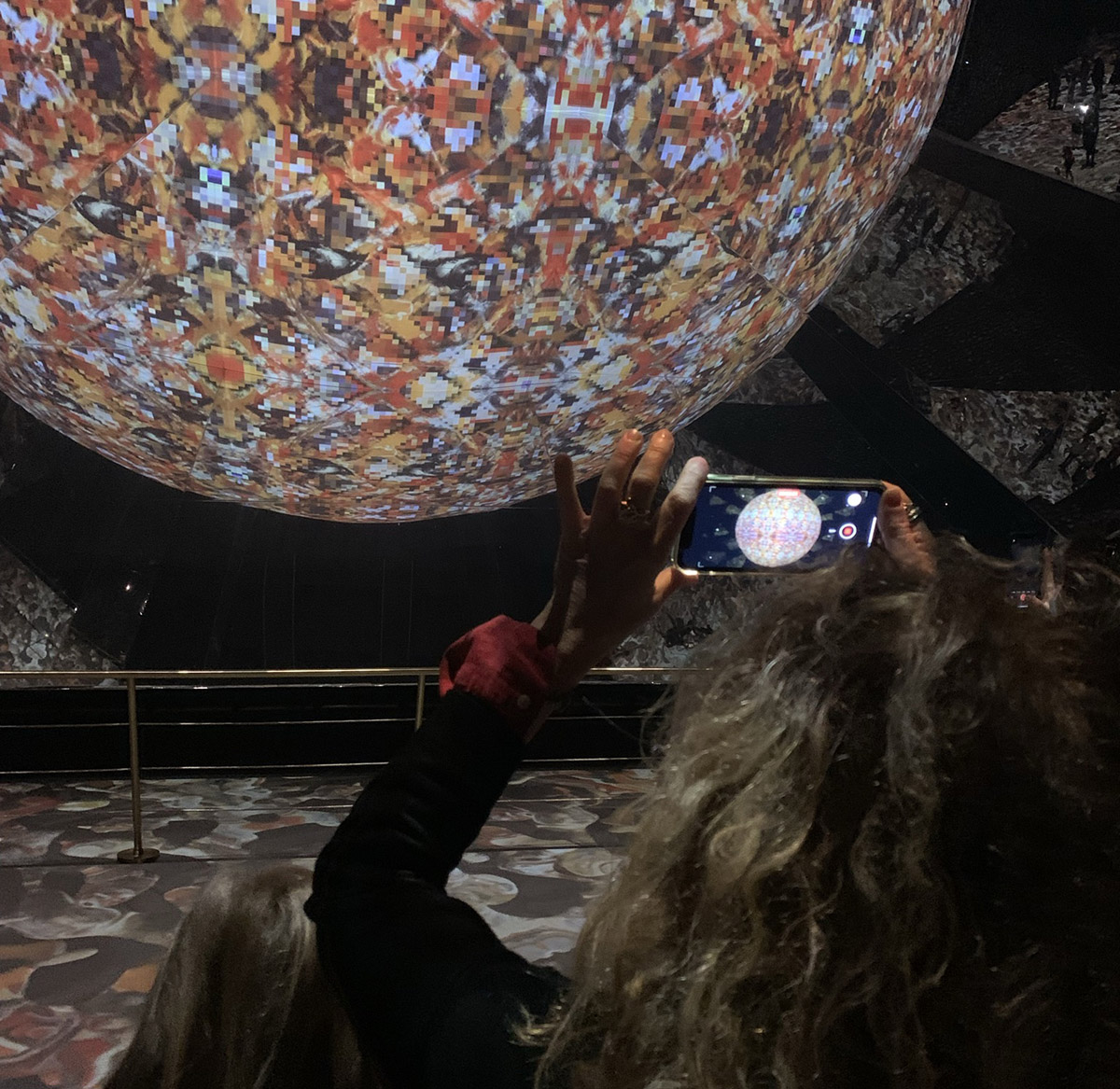
Kingdom of Saudi Arabia Pavillon experience. Image © Antonello Magliozzi
Al Wasl, the square with the dome about 70 meters high and 150 meters wide, is a work of the American studio Adrian Smith + Gordon Gill recalling forms of past Arab architecture. It represents the beating heart of the Expo, and it is composed by cutting-edge metal structure and a translucent fabric that protect from sunlight during the day, providing also a backdrop for fantastic light projections at night. An extraordinary transit point that privileges the view of the largest 360-degree screen ever created, with a virtual experience that can be viewed from inside and outside. From here start the three petals-districts that include the different pavilions inspired by the same themes, and culminating with macro-pavilions symbolizing the districts. Each pavilion has a message in its envelope, in its architecture that sometimes surprises for the immediacy of the message narrated, as well as for the quality of the expressive language. These have representative functions in forms and technologies, as well as with the use of natural and artificial light, and thus determining different experiences depending on the time of day. During daytime, they fascinate for their plasticity and tangibility, while at night they impress for the immateriality of lights and colors of immersive LED screens, which completely reinvent the space and the architectural aspect of the pavilions themselves.
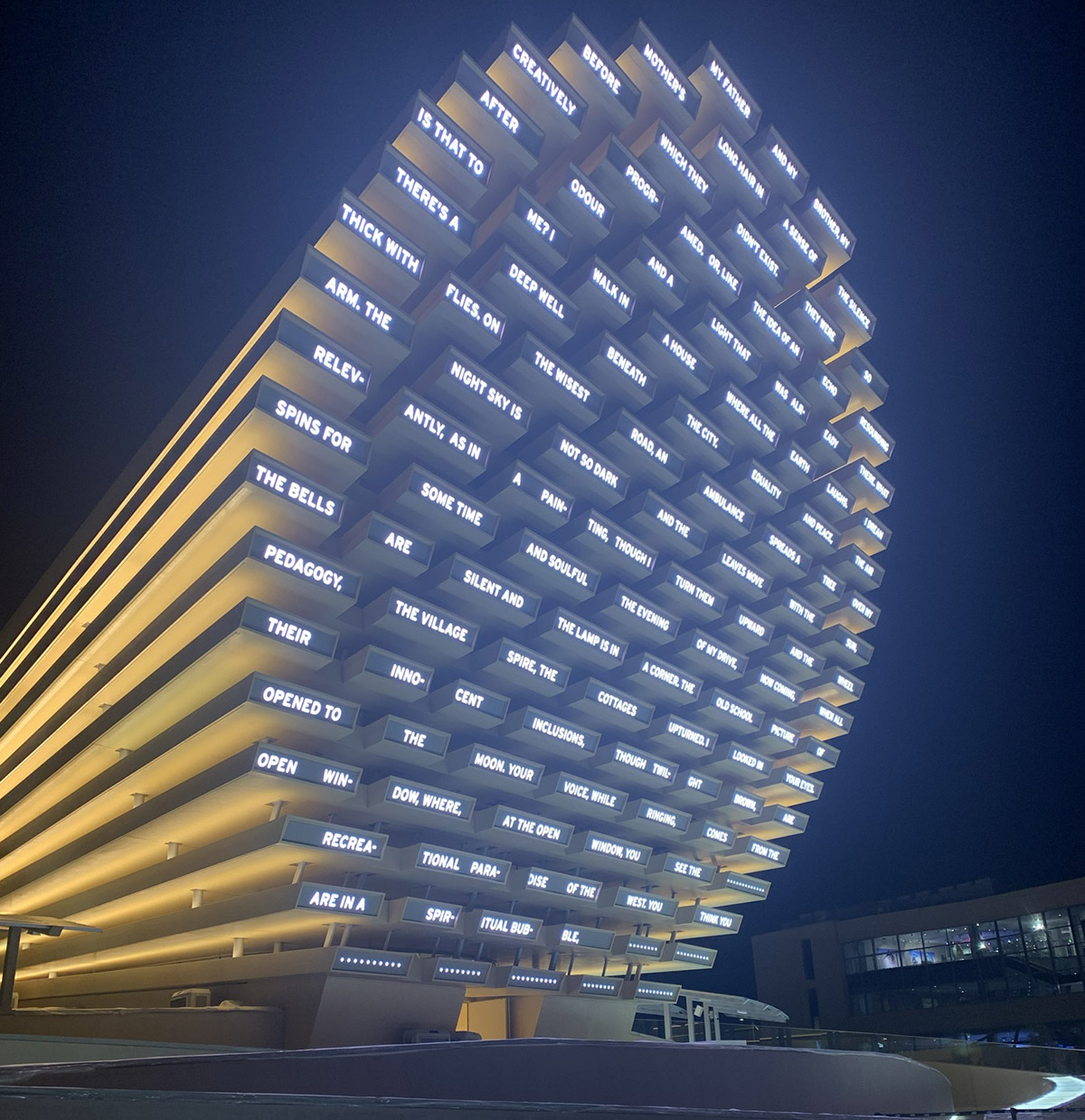
UK Pavillon experience. Image © Antonello Magliozzi
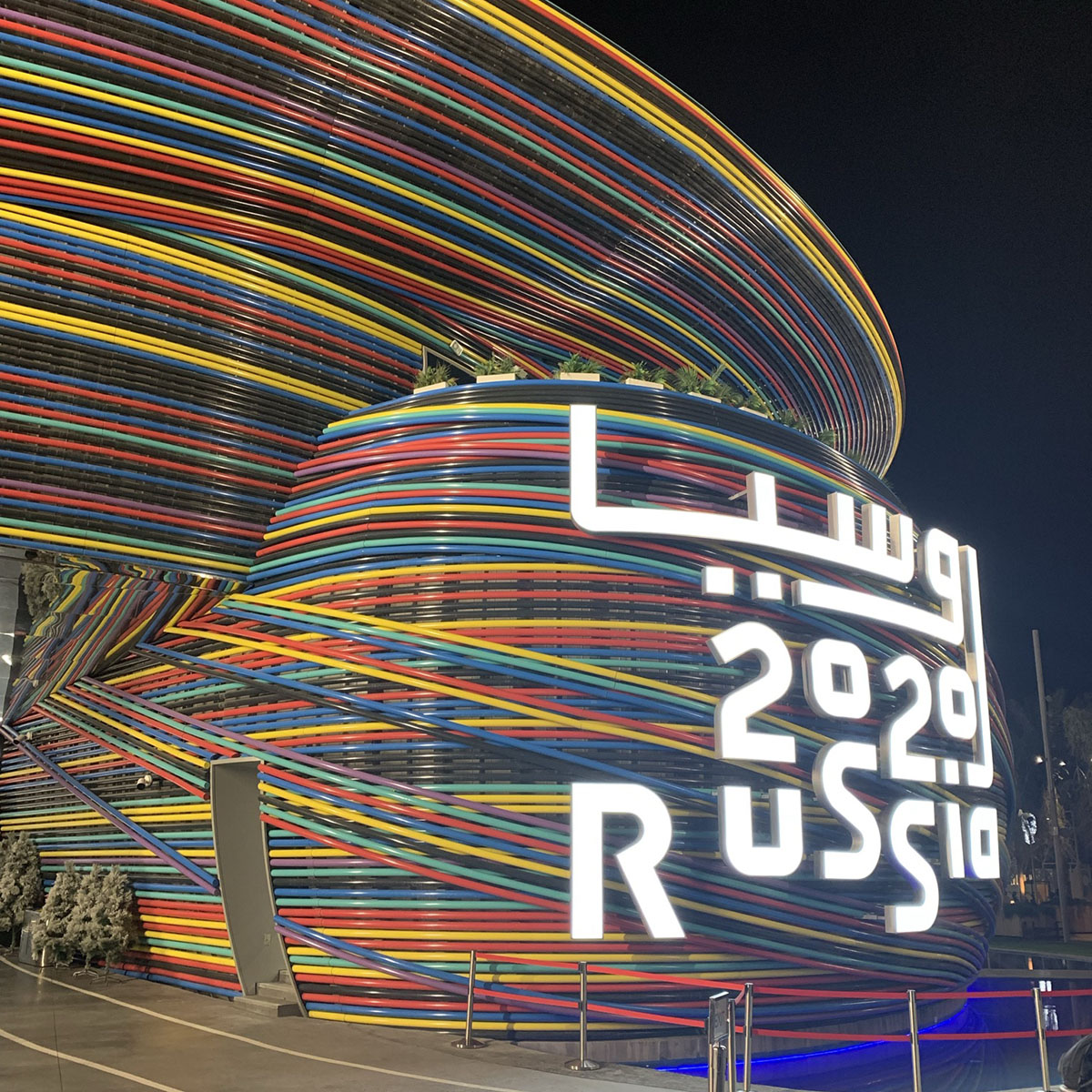
Russia Pavillon experience. Image © Antonello Magliozzi
The Expo offers a space-temporal experience that is seemingly consumerist, but is actually the result of applying sound green principles to allow for the effective freedom of the 21st century innovation. The entire complex uses renewable sources, with a total capacity of 5.5 megawatts, and is composed of buildings with materials that adhere to strict circularity protocols. It includes a landscape composed of 90 percent native ornamental plants to ensure biodiversity, and adopts strategies to reduce water needs by 50 percent from standards. The Expo actualizes the idea of a "Mission Possible" and, as in the Opportunity Pavilion designed by AGi Architects, tells the story of the concrete application of the Sustainable Development Goals (SDGs). In this important architectural episode of the exhibition, a large square is represented as a Roman agora, to emphasize the need for a common ground, useful for intercultural social commitment to save the planet. For the same purposes, the building dedicated to the UN, incorporates clouds and dreams through a floating canopy composed of metal structures and six layers of fabric to protect from sun exposure, while creating a backdrop to neutralize the embodied carbon footprint through natural materials such as terracotta. Inside, it features multimedia pathways that represent the basic human needs of water, food and energy to testify to the possibility of creating a better future for everyone.
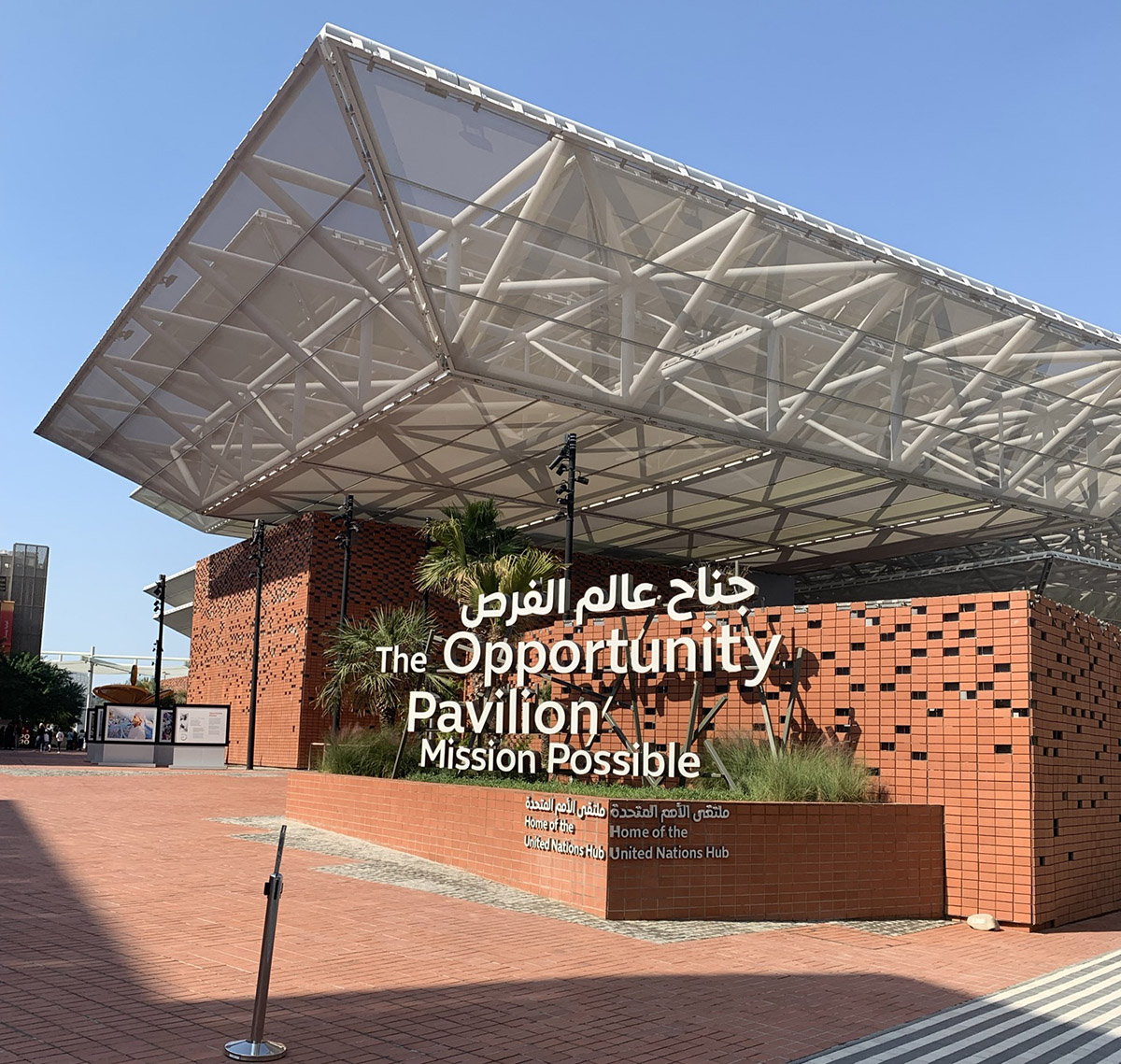
Mission Possibile, Opportunity Pavillon. Image © Antonello Magliozzi
The place that literally embodies the Expo's idea of sustainability is the Terra Pavilion. This is also called the Sustainability Pavilion, and was built on the design by Grimshaw Architects, which is inspired by natural processes such as photosynthesis in order to provide a zero-energy-water building. It has a dynamic form to serve its function, capturing energy from sunlight and fresh water from moist air, and is located in a biodiverse landscape, consisting of flora from the surrounding deserts, along with areas of halophilic agriculture, amidst several photovoltaic "energy trees”. It is distinguished by a magnificent 130-meter-diameter canopy, equipped with 1,055 ultra-efficient PV panels, which works with the courtyard to both direct fresh air inside and simultaneously vent warm air outside through a central chimney. It includes basement spaces to maximize the earth's own insulation properties, and it is protected by walls of local light-colored stone to naturally refract the sun's rays while providing adequate thermal mass. Right in the basement spaces, the building includes two interactive paths through the roots of forests and oceans. These are aimed at positively changing visitor behavior, from rationalizing water consumption to raising awareness of the importance of reducing plastic use, for moving toward a cleaner, safer, healthier world.
Terra Pavillon © Expo 2020 via Youtube
The fact the Expo aims at innovation to access a sustainable future is immediately evident as soon as one cross one of the three gigantic entrance portals in carbon fiber, the work of architect Asif Khan. The way the Expo refers to the theme of mobility through new solutions, even reinterpreting the concept of speed, may seem truly surprising. Indeed, the mobility district tells of self-driving vehicles, sophisticated automotive technologies and space travel within futuristic pavilions. Impressive in this regard is the volumetric effect of Alif - the Mobility Pavilion by Norman Foster - an enormous propeller of gleaming metal, which immediately communicates dynamism through the fluidity of its forms. A sort of engine with an idea of speed that can be associated with the movement of things and people, as well as information, and which inside narrates the breaking down of the gap between the physical and digital worlds. A building that features a highly reflective self-shading façade to lower global warming, as well as smart energy-saving technologies. All together with renewable installations that can provide most of the internal charges, including those related to the main elevator in the central interior space, which can accommodate up to 160 people. An overall "leap in time" narrating possible forms of sustainable mobility of a global network.
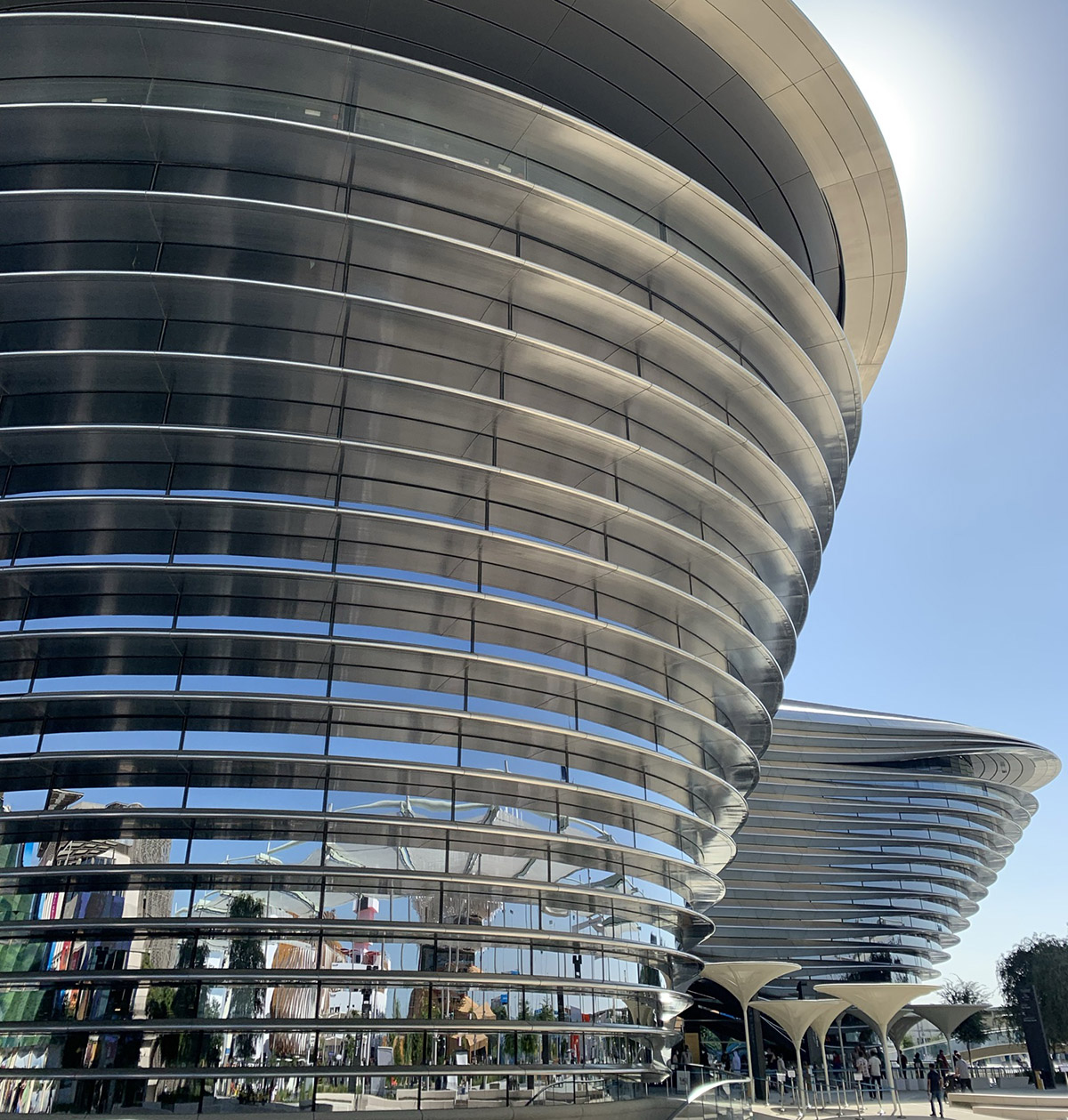
Alif, the Mobility Pavillon. Image © Antonello Magliozzi
What makes the Dubai Expo experience truly unique is the mix of testimonies from the various pavilions. Many are unmissable, such as that of the United Arab Emirates, the work of Santiago Calatrava, which tells the story, objectives and successes of a people, within a building that uses a form evocative of the flight of a falcon, while adopting both cutting-edge adaptive technologies and materials of the Emirati tradition. Alternatively, to take another example, the multi-colored dome of Russia's pavilion designed by Sergei Tchoban is truly stunning. This includes an augmented reality display, with a hyper-realistic kinetic sculpture of the brain, symbolizing the endless human cognitive process as part of the ceaseless technological progress. On the other hand, it is evocative, but with a completely different expressive language, the Singapore pavilion. A work by the WOHA studio that points to a world in which "nature nurture the future" through a three-dimensional green building that houses 170 varieties of plants, representing innovation for the mitigation of climate change. This is a very different experience from the one that can instead be lived in the much visited pavilion of Japan, inside a building designed by Yuko Nagayama, where the open façade like an origami, with a pattern resulting from the fusion of Arab and Asanoha forms, generates a fascinating and efficient model of bio-climatic.
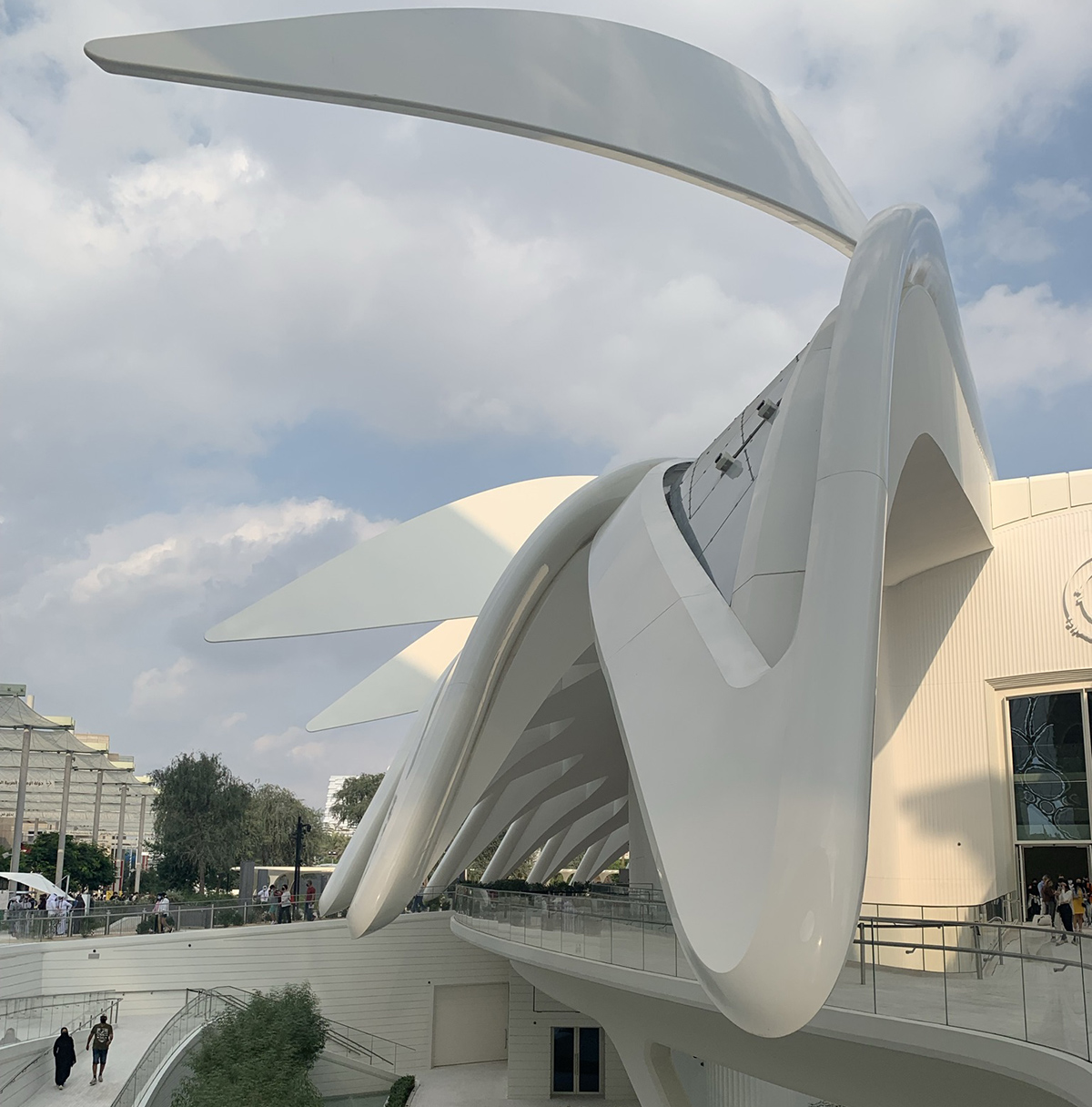
UAE Pavillon. Image © Antonello MagliozzI
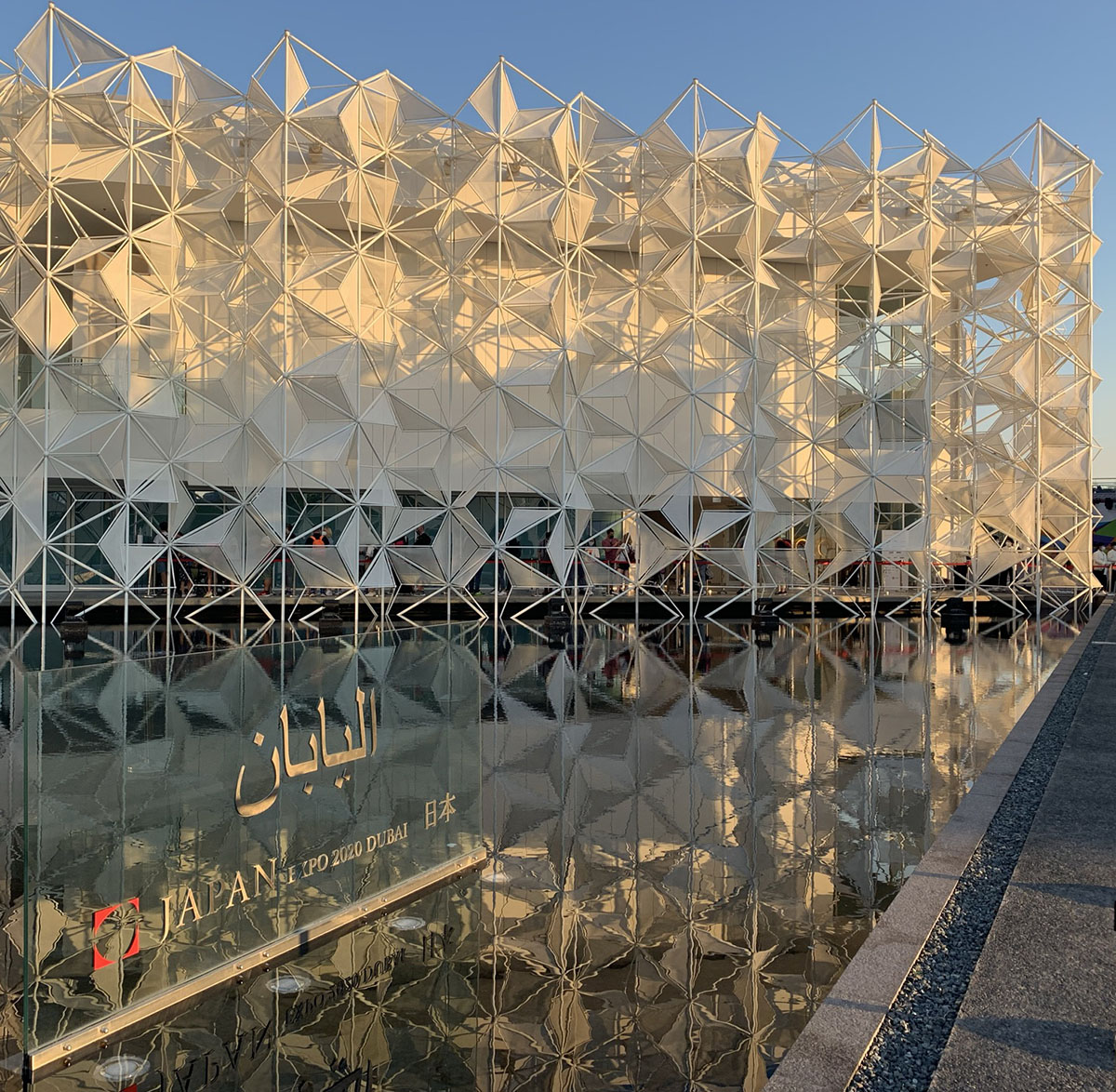
Japan Pavillon. Image © Antonello MagliozzI
At the Expo, there are certainly many other examples of best practices of sustainability through the application of circular processes. A working methodology that is represented, for example, in the evocative eco-system pavilion of Sweden, "the Forest" by Ripellino Arkitekter, or in that of Italy, the work of architect Carlo Ratti, which is inspired by the concept of "beauty connecting mind" through the creative recycling of materials. In this case, in a building equipped with a natural temperature control system, the elevations are not enclosed by walls, but protected by 70 kilometers of recycled plastic cordage, according to a cradle-to-cradle approach. In the vision of its creator, the pavilion has also a roof made of three capsized boats, which, once the exhibition is over, will be able to sail to new destinations. Thus, the set of narratives of the various pavilions of the Expo depicts an overall framework of sustainability, not as a merely abstract or visionary value, but as a physical-scientific essence that is meant for today's real world, in the perspective of a life cycle that concerns the world of tomorrow. We could then say that precariousness and permanence are key concepts of Expo, since these represent a dynamic balance of human needs within the socio-economic-environmental ecosystem. For this reason, the systems and technologies narrated in the exhibition, which is defined as the most sustainable, are conceived to be open to continuous change, to adapt and transform, to be always usable and reusable in a circular way.

Sweden Pavillon. Image © Antonello Magliozzi
Unlike other universal expositions, about 80% of all Expo 2020 buildings are built to last beyond the end of the event, to create a smart citiy that will drive digital and energy innovation in the Middle East. A kind of green-tech-bio-system that, as expressed by the Expo organization, will be able to become a permanent phenomenon, "to provide a working and living environment that will constantly evolve to meet the changing needs of local and international communities." A district that will thus be able to fulfill the promises of the realization of new forms of transportation that are faster, safer, cheaper and more sustainable, such as those of the Hyperloop, the super train that travels at 1200 km per hour. A district that will then be able to collaborate with other innovative hubs in other regions of the world, for example with MIND - Milano Innovation District, where the aim is also to experiment with new ways of working, researching and living, through a regeneration of the Expo 2015 site. Thus, in Dubai, in the place that imagines the impossible as possible “connecting minds”, the idea of connecting intelligences of the planet for a truly sustainable innovation becomes concrete. Because, as Director Reem Al Hashimy stated a year before Expo opened: "great things can happen when we bring the world together." A phrase that rings even truer today, since it crystallize the sustainability vision of yesterday, today and tomorrow throughout the Dubai Expo 2020 experience.
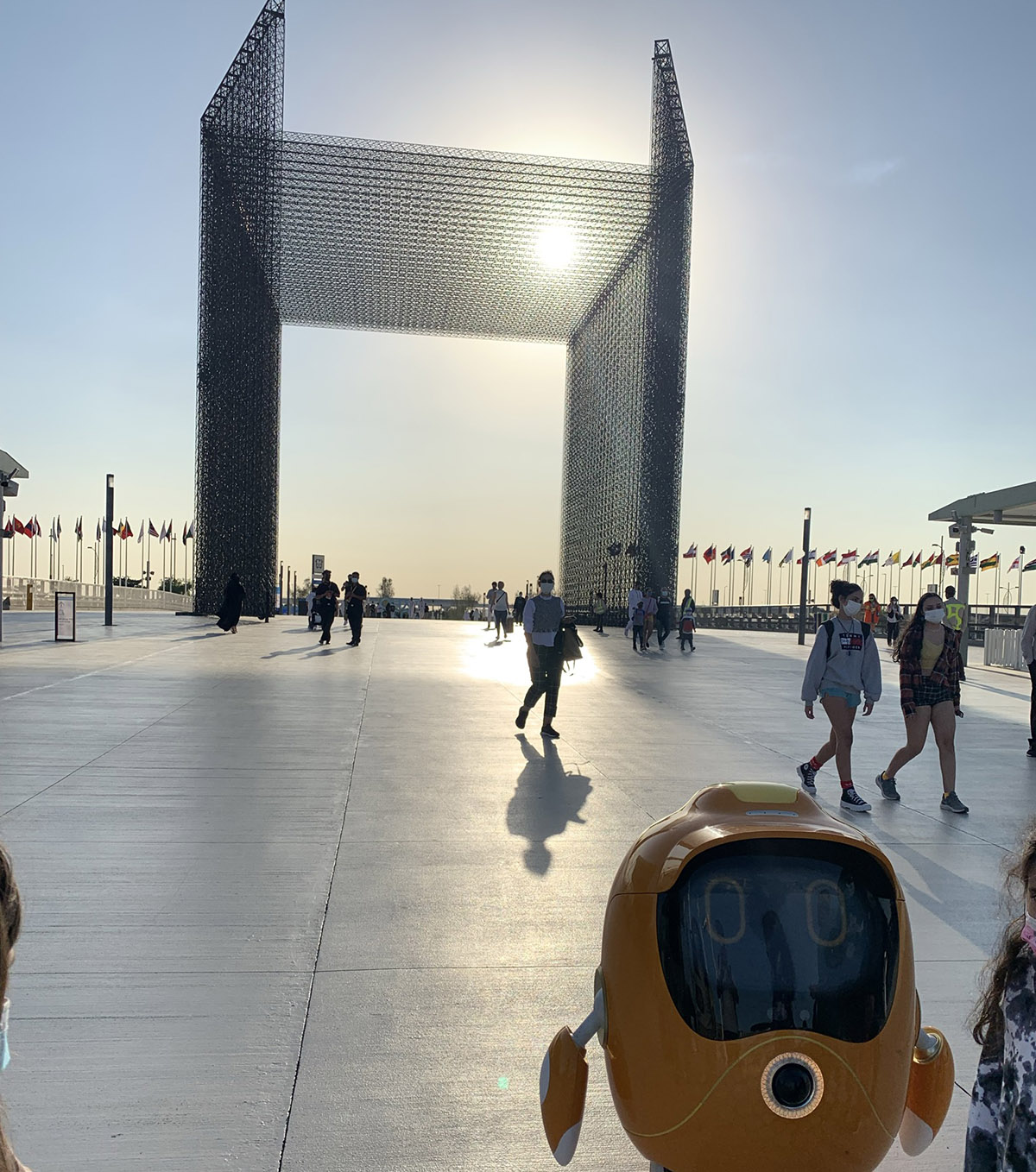
Expo Dubai gateway. Image © Antonello Magliozzi
Top image courtesy of Antonello Magliozzi.
